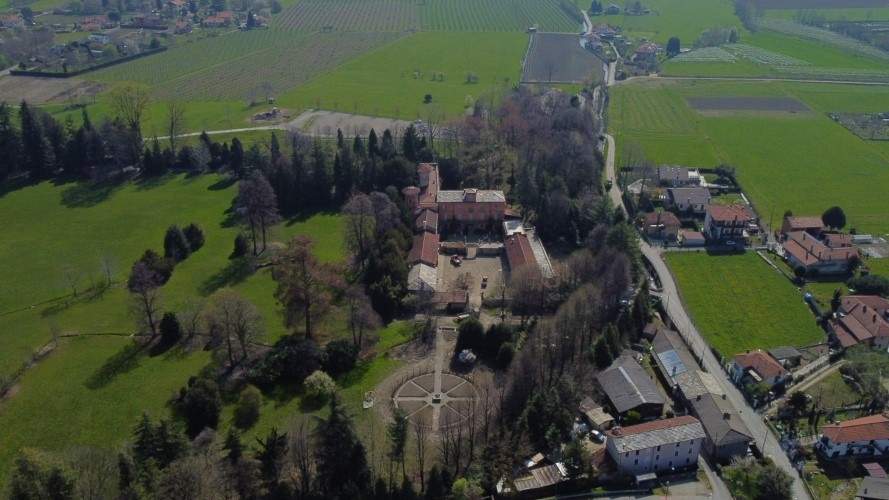The Miradolo Castle Garden at San Secondo di Pinerolo (Turin) opens to the public for the first time: visits will be possible as soon as government anti-Covid restrictions on museums are removed. This is a major achievement for the Piedmont site, however, because the idea of reviving the kitchen garden at Miradolo Castle was a desire chased for damage, which came to life thanks to the skill of architect Paolo Pejrone (Turin, 1941) and the many people who made it possible to restore it. The garden will thus be unveiled to the public on the occasion of the exhibition Beyond the Garden. The Abbecedario of Paolo Pejrone, which the Cosso Foundation will dedicate to the architect from May 15, 2021 to May 15, 2022.
The garden of Miradolo Castle overlooks the rustic courtyard of the ancient mansion and complements its original agricultural vocation, with a stable, barn, oven, chicken coop and wash house. It develops around the central axis that runs through the gateway to the ancient “cassina,” the farmyard and the palace, to the round tower. Seen from above, the kitchen garden fits perfectly into the design of the place. The materials, almost all of them found at the Castle and scattered throughout the Park, have guided the construction choices: the design of the kitchen garden has been retraced with local and ancient stones; along the perimeter, chestnut wood posts have been inserted, mounted on stone stelae, as was once used in the ancient Pinerolo countryside. Rows of white grapes will frame the vegetable garden, running along the fence, and at the foot will grow wild strawberries, carnations, lilies of the valley, peonies, hellebores and other delicate essences. Inside the garden, horticultural and floral plants, repurposed among rare and ancient species: among the vegetables, radishes, spring onions, cabbage, tomatoes, cucumbers, sarsèt, parsley, basil, rughetta, peas, fava beans, artichokes and leeks, and then dahlias, calla lilies, marigolds, nasturtiums, zinnias and azeruoli.
The interior walkways are made of “calatà”: rustic paving, also known as “Piedmontese cobblestones,” created in ancient times with pebbles derived from the stoning of fields. All in harmony with the ancient paving of the rustic courtyard and as its continuation and extension. In the center of the garden is a square stone basin, repurposed from old slabs found at the castle. The water is in perpetual motion: it flows uninterruptedly, fed by the ancient well.
“For years,” explains Paola Eynard, vice-president of the Cosso Foundation, "I had nurtured the dream of recovering the rustic part of Miradolo Castle. To do so required great grace and finding capable and sensitive collaborators to interpret the idea of a delicate recovery that respects the signs of time. This project aims to pass on the history of the place and, with it, an ancient vocation and knowledge: every space hides a story, you just have to know how to listen. For the vegetable garden, a longtime desire of mine, I asked Paolo Pejrone for help because he knows perfectly well that flavor of home, farmstead and agricultural that characterizes places like this
The exhibition Beyond the Garden. The Abbecedario of Paolo Pejrone, curated by Paola Eynard and Roberto Galimberti, will be developed around the concept of the “abbecedario”: an ideal path, in strict alphabetical dis-order, of thoughts, references, doubts and hopes, to learn how to read not only the garden but the great themes that, in contemporary times, represent the challenge we are experiencing in the relationship between man and the environment. The A for anarchy and trees, the T for time, the P for patience, the S for dream, and the O for vegetable garden are just a few examples. The reintroduction of the vegetable garden is also part of an extensive program that the Cosso Foundation is dedicating for the coming months to educational activities, literary and popular meetings to explore the themes of landscape, environment and biodiversity. On this occasion, for the first time, the rustic buildings, the oldest core of the property, will be open to visitors. In fact, archival research reveals that already in the 17th century there was a “cassina,” accompanied by ample land, vineyards and orchards, owned by the Macello family, later Massel di Caresana, around which the “palace” and “garden” of Miradolo would later be built between the 18th and 19th centuries. In the coming months, these spaces will return to tell their story.
The Historical Park will reopen for visits as soon as possible. For info on hours and openings, see fondazionecosso.it or call 0121 502761.
Pictured: the castle and kitchen garden from above.
 |
| Piedmont, restored Miradolo Castle vegetable garden opens to the public for the first time |
Warning: the translation into English of the original Italian article was created using automatic tools. We undertake to review all articles, but we do not guarantee the total absence of inaccuracies in the translation due to the program. You can find the original by clicking on the ITA button. If you find any mistake,please contact us.